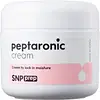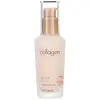What's inside
What's inside
 Key Ingredients
Key Ingredients

 Benefits
Benefits

 Concerns
Concerns

 Ingredients Side-by-side
Ingredients Side-by-side

Water
Skin ConditioningGlycerin
HumectantCaprylic/Capric Triglyceride
MaskingDipropylene Glycol
HumectantCetyl Ethylhexanoate
EmollientNiacinamide
SmoothingCetyl Alcohol
EmollientPalmitic Acid
EmollientGlyceryl Stearate
EmollientStearic Acid
CleansingEthylhexylglycerin
Skin ConditioningCarbomer
Emulsion StabilisingPolysorbate 60
EmulsifyingArginine
MaskingTrehalose
HumectantHydroxyacetophenone
AntioxidantChlorphenesin
AntimicrobialPanthenol
Skin ConditioningParfum
MaskingMacadamia Integrifolia Seed Oil
Skin ConditioningAdenosine
Skin ConditioningDisodium EDTA
Butylene Glycol
HumectantStearyl Alcohol
EmollientMyristyl Alcohol
Emollient1,2-Hexanediol
Skin ConditioningPentylene Glycol
Skin ConditioningPolyglyceryl-10 Laurate
Skin ConditioningSodium Hyaluronate
HumectantBeta-Glucan
Skin ConditioningCaprylyl Glycol
EmollientSodium Hyaluronate Crosspolymer
HumectantHydrolyzed Hyaluronic Acid
HumectantHyaluronic Acid
HumectantTocopherol
AntioxidantHydrolyzed Sodium Hyaluronate
Skin ConditioningCopper Tripeptide-1
Skin ConditioningHexapeptide-11
Skin ConditioningPalmitoyl Pentapeptide-4
Skin ConditioningPalmitoyl Tripeptide-1
Skin ConditioningTripeptide-1
Skin ConditioningHexapeptide-9
Skin ConditioningWater, Glycerin, Caprylic/Capric Triglyceride, Dipropylene Glycol, Cetyl Ethylhexanoate, Niacinamide, Cetyl Alcohol, Palmitic Acid, Glyceryl Stearate, Stearic Acid, Ethylhexylglycerin, Carbomer, Polysorbate 60, Arginine, Trehalose, Hydroxyacetophenone, Chlorphenesin, Panthenol, Parfum, Macadamia Integrifolia Seed Oil, Adenosine, Disodium EDTA, Butylene Glycol, Stearyl Alcohol, Myristyl Alcohol, 1,2-Hexanediol, Pentylene Glycol, Polyglyceryl-10 Laurate, Sodium Hyaluronate, Beta-Glucan, Caprylyl Glycol, Sodium Hyaluronate Crosspolymer, Hydrolyzed Hyaluronic Acid, Hyaluronic Acid, Tocopherol, Hydrolyzed Sodium Hyaluronate, Copper Tripeptide-1, Hexapeptide-11, Palmitoyl Pentapeptide-4, Palmitoyl Tripeptide-1, Tripeptide-1, Hexapeptide-9
Water
Skin ConditioningHydrolyzed Collagen
EmollientGlycereth-26
HumectantButylene Glycol
HumectantCyclomethicone
EmollientButylene Glycol Dicaprylate/Dicaprate
EmollientMangifera Indica Seed Butter
Skin ConditioningPEG-32
HumectantGlyceryl Polyacrylate
Ethoxydiglycol
HumectantPEG-20 Methyl Glucose Sesquistearate
EmulsifyingLaminaria Japonica Extract
Skin ProtectingCetyl Alcohol
EmollientPolysorbate 60
EmulsifyingPolyacrylate-13
Sorbitan Oleate
EmulsifyingCaprylyl Glycol
EmollientPolyisobutene
Parfum
MaskingMethyl Glucose Sesquistearate
EmollientGlycerin
HumectantEthylhexylglycerin
Skin ConditioningDimethicone
EmollientHydrolyzed Malt Extract
Skin ConditioningSaussurea Involucrata Extract
HumectantTocopheryl Acetate
AntioxidantPanthenol
Skin ConditioningStearic Acid
CleansingPolysorbate 20
EmulsifyingArctostaphylos Uva Ursi Leaf Extract
Skin ConditioningCarbomer
Emulsion StabilisingTriethanolamine
BufferingXanthan Gum
EmulsifyingBHT
AntioxidantDisodium EDTA
CI 15985
Cosmetic ColorantCI 14700
Cosmetic ColorantWater, Hydrolyzed Collagen, Glycereth-26, Butylene Glycol, Cyclomethicone, Butylene Glycol Dicaprylate/Dicaprate, Mangifera Indica Seed Butter, PEG-32, Glyceryl Polyacrylate, Ethoxydiglycol, PEG-20 Methyl Glucose Sesquistearate, Laminaria Japonica Extract, Cetyl Alcohol, Polysorbate 60, Polyacrylate-13, Sorbitan Oleate, Caprylyl Glycol, Polyisobutene, Parfum, Methyl Glucose Sesquistearate, Glycerin, Ethylhexylglycerin, Dimethicone, Hydrolyzed Malt Extract, Saussurea Involucrata Extract, Tocopheryl Acetate, Panthenol, Stearic Acid, Polysorbate 20, Arctostaphylos Uva Ursi Leaf Extract, Carbomer, Triethanolamine, Xanthan Gum, BHT, Disodium EDTA, CI 15985, CI 14700
 Reviews
Reviews

Ingredients Explained
These ingredients are found in both products.
Ingredients higher up in an ingredient list are typically present in a larger amount.
Butylene Glycol (or BG) is used within cosmetic products for a few different reasons:
Overall, Butylene Glycol is a safe and well-rounded ingredient that works well with other ingredients.
Though this ingredient works well with most skin types, some people with sensitive skin may experience a reaction such as allergic rashes, closed comedones, or itchiness.
Learn more about Butylene GlycolCaprylyl Glycol is a humectant and emollient, meaning it attracts and preserves moisture.
It is a common ingredient in many products, especially those designed to hydrate skin. The primary benefits are retaining moisture, skin softening, and promoting a healthy skin barrier.
Though Caprylyl Glycol is an alcohol derived from fatty acids, it is not the kind that can dry out skin.
This ingredient is also used as a preservative to extend the life of products. It has slight antimicrobial properties.
Learn more about Caprylyl GlycolCarbomer is a polymer of acrylic acid. Its main role is to create a gel consistency.
A high amount of carbomer can cause pilling or balling up of products. Don't worry, most products contain 1% or less of carbomer.
Cetyl Alcohol is a fatty alcohol. Fatty Alcohols are most often used as an emollient or to thicken a product.
Its main roles are:
Though it has "alcohol" in the name, it is not related to denatured alcohol or ethyl alcohol.
The FDA allows products labeled "alcohol-free" to have fatty alcohols.
Learn more about Cetyl AlcoholDisodium EDTA plays a role in making products more stable by aiding other preservatives.
It is a chelating agent, meaning it neutralizes metal ions that may be found in a product.
Disodium EDTA is a salt of edetic acid and is found to be safe in cosmetic ingredients.
Learn more about Disodium EDTAEthylhexylglycerin (we can't pronounce this either) is commonly used as a preservative and skin softener. It is derived from glyceryl.
You might see Ethylhexylglycerin often paired with other preservatives such as phenoxyethanol. Ethylhexylglycerin has been found to increase the effectiveness of these other preservatives.
Glycerin is already naturally found in your skin. It helps moisturize and protect your skin.
A study from 2016 found glycerin to be more effective as a humectant than AHAs and hyaluronic acid.
As a humectant, it helps the skin stay hydrated by pulling moisture to your skin. The low molecular weight of glycerin allows it to pull moisture into the deeper layers of your skin.
Hydrated skin improves your skin barrier; Your skin barrier helps protect against irritants and bacteria.
Glycerin has also been found to have antimicrobial and antiviral properties. Due to these properties, glycerin is often used in wound and burn treatments.
In cosmetics, glycerin is usually derived from plants such as soybean or palm. However, it can also be sourced from animals, such as tallow or animal fat.
This ingredient is organic, colorless, odorless, and non-toxic.
Glycerin is the name for this ingredient in American English. British English uses Glycerol/Glycerine.
Learn more about GlycerinPanthenol is a common ingredient that helps hydrate and soothe the skin. It is found naturally in our skin and hair.
There are two forms of panthenol: D and L.
D-panthenol is also known as dexpanthenol. Most cosmetics use dexpanthenol or a mixture of D and L-panthenol.
Panthenol is famous due to its ability to go deeper into the skin's layers. Using this ingredient has numerous pros (and no cons):
Like hyaluronic acid, panthenol is a humectant. Humectants are able to bind and hold large amounts of water to keep skin hydrated.
This ingredient works well for wound healing. It works by increasing tissue in the wound and helps close open wounds.
Once oxidized, panthenol converts to pantothenic acid. Panthothenic acid is found in all living cells.
This ingredient is also referred to as pro-vitamin B5.
Learn more about PanthenolParfum is a catch-all term for an ingredient or more that is used to give a scent to products.
Also called "fragrance", this ingredient can be a blend of hundreds of chemicals or plant oils. This means every product with "fragrance" or "parfum" in the ingredients list is a different mixture.
For instance, Habanolide is a proprietary trade name for a specific aroma chemical. When used as a fragrance ingredient in cosmetics, most aroma chemicals fall under the broad labeling category of “FRAGRANCE” or “PARFUM” according to EU and US regulations.
The term 'parfum' or 'fragrance' is not regulated in many countries. In many cases, it is up to the brand to define this term.
For instance, many brands choose to label themselves as "fragrance-free" because they are not using synthetic fragrances. However, their products may still contain ingredients such as essential oils that are considered a fragrance by INCI standards.
One example is Calendula flower extract. Calendula is an essential oil that still imparts a scent or 'fragrance'.
Depending on the blend, the ingredients in the mixture can cause allergies and sensitivities on the skin. Some ingredients that are known EU allergens include linalool and citronellol.
Parfum can also be used to mask or cover an unpleasant scent.
The bottom line is: not all fragrances/parfum/ingredients are created equally. If you are worried about fragrances, we recommend taking a closer look at an ingredient. And of course, we always recommend speaking with a professional.
Learn more about ParfumPolysorbate 60 is used to help stabilize products. It is a surfactant and emulsifier. These properties help keep ingredients together in a product. Surfactants help reduce surface tension between ingredients with different states, such as liquids and solids. Emulsifiers help prevent oils and waters from separating.
Polysorbate 60 is sorbitol-based and created from the ethoxylation of sorbitan. Ethoxylation is a chemical reaction used to add ethylene oxide. Sorbitan is a the dehydrated version of sorbitol, a sugar found in fruits.
In this case, the 60 comes from reacting 60 units of ethylene oxide with sorbitan.
Polysorbates are commonly used in medicine and foods.
Learn more about Polysorbate 60Stearic Acid is a fatty acid. It is an emollient, emulsifier, and texture enhancer.
As an emollient, stearic acid helps soften skin. It aids the skin's protective barrier by preventing water loss. It also provides a gentle cleansing effect without stripping away natural oils.
Stearic acid may also be used to enhance the texture of products. It can add volume and stabilize ingredients such as water and oil. This can help water and oil ingredients from separating.
Sources of stearic acid include animal or vegetable fats/oils such as coconut or shea. It can be naturally found in butter, cocoa butter, shea butter, vegetable fats, and animal tallow.
This ingredient may not be Malassezia folliculitis, or fungal-acne safe.
Learn more about Stearic AcidWater. It's the most common cosmetic ingredient of all. You'll usually see it at the top of ingredient lists, meaning that it makes up the largest part of the product.
So why is it so popular? Water most often acts as a solvent - this means that it helps dissolve other ingredients into the formulation.
You'll also recognize water as that liquid we all need to stay alive. If you see this, drink a glass of water. Stay hydrated!
Learn more about Water